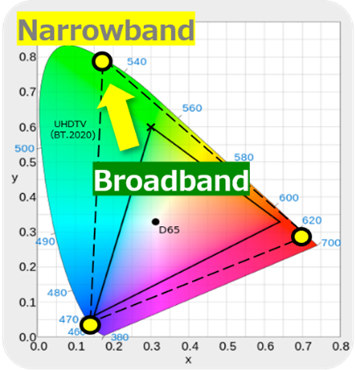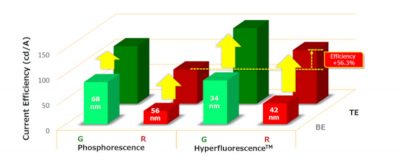Kyulux explains the benefits of TADF/Hyperfluorescence™ systems at ICDT 2021
Last week at ICDT 2021, Dr. Shou-Hsien Cheng of Kyulux presented Kyulux’s latest progress in a talk entitled “HyperfluorescenceTM: Excel the Performance, Create the Future.”
In this talk, Kyulux demonstrated its coherent Hyperfluorescence™ development approach, consisting of comparative simulation, experimental demos, and a strategy towards high current efficiency alongside its new blue and green TADF materials design principle for significant device lifetime improvement. These achievements were obtained by utilizing Kyulux’s “Kyumatic” Materials Informatics system. Kyulux plans to expand the capabilities of the Kyumatic system by adding more data and information about the durability of OLED devices.
Since Hyperfluorescence™ works fourfold more efficiently than the conventional fluorescence according to the emitting mechanism, the revealed Blue Index (BI) simulation also complied with this tendency. Moreover, the intrinsically narrow bandwidth of Hyperfluorescence™ enables a much more superior efficiency growth when converting its bottom emission structure to top emission one.
 This feature makes Hyperfluorescence™ a more attractive OLED emitting technology over phosphorescence. Kyulux also looks forward to further boosting its Hyperfluorescence™ performances via optical property manipulation of the fluorescence emitters.
This feature makes Hyperfluorescence™ a more attractive OLED emitting technology over phosphorescence. Kyulux also looks forward to further boosting its Hyperfluorescence™ performances via optical property manipulation of the fluorescence emitters.
 In addition to the progress that stems from device optimization, Kyulux also announced its latest lifetime breakthrough in blue and green TADF development. Based on the latest innovative materials design principle, the new generation of TADF materials possesses expedited electron mobility and a well-tuned LUMO energy level. Thereby, the new TADF materials substantially improved the electron injection/transport issues, and the blue and green TADF device lifetime has also been prolonged by 5 and 1.65 times, respectively.
In addition to the progress that stems from device optimization, Kyulux also announced its latest lifetime breakthrough in blue and green TADF development. Based on the latest innovative materials design principle, the new generation of TADF materials possesses expedited electron mobility and a well-tuned LUMO energy level. Thereby, the new TADF materials substantially improved the electron injection/transport issues, and the blue and green TADF device lifetime has also been prolonged by 5 and 1.65 times, respectively.
 With these fruitful Hyperfluorescence™ improvements within a short period of time, Kyulux has the confidence to predict further significant performance growth and should be ready for practical mobile applications shortly.
With these fruitful Hyperfluorescence™ improvements within a short period of time, Kyulux has the confidence to predict further significant performance growth and should be ready for practical mobile applications shortly.
 This feature makes Hyperfluorescence™ a more attractive OLED emitting technology over phosphorescence. Kyulux also looks forward to further boosting its Hyperfluorescence™ performances via optical property manipulation of the fluorescence emitters.
This feature makes Hyperfluorescence™ a more attractive OLED emitting technology over phosphorescence. Kyulux also looks forward to further boosting its Hyperfluorescence™ performances via optical property manipulation of the fluorescence emitters.
 In addition to the progress that stems from device optimization, Kyulux also announced its latest lifetime breakthrough in blue and green TADF development. Based on the latest innovative materials design principle, the new generation of TADF materials possesses expedited electron mobility and a well-tuned LUMO energy level. Thereby, the new TADF materials substantially improved the electron injection/transport issues, and the blue and green TADF device lifetime has also been prolonged by 5 and 1.65 times, respectively.
In addition to the progress that stems from device optimization, Kyulux also announced its latest lifetime breakthrough in blue and green TADF development. Based on the latest innovative materials design principle, the new generation of TADF materials possesses expedited electron mobility and a well-tuned LUMO energy level. Thereby, the new TADF materials substantially improved the electron injection/transport issues, and the blue and green TADF device lifetime has also been prolonged by 5 and 1.65 times, respectively.
 With these fruitful Hyperfluorescence™ improvements within a short period of time, Kyulux has the confidence to predict further significant performance growth and should be ready for practical mobile applications shortly.
With these fruitful Hyperfluorescence™ improvements within a short period of time, Kyulux has the confidence to predict further significant performance growth and should be ready for practical mobile applications shortly. 


